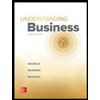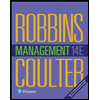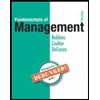
To determine:
The difference between internal and external stakeholders.
Introduction:
Internal and external stakeholders
Every organization has stakeholders that can be classified as internal stakeholders and external stakeholders. Internal stakeholders are individuals or parties within the organization. Whereas, external stakeholders are individuals or parties that are outside the organization, which affect the business.
Internal stakeholders are also called primary stakeholders that provide direct services to the company. They are those parties that get directly affected by the business. They can influence and get influenced by the success and failure of the business. Without internal stakeholders the company will not be able to function.
External stakeholders are also called secondary stakeholders that do not participate in the day to day business of the organization. They are those parties that deal with the company externally without interfering in the business affairs and do not get directly affected by the business. They are not involved directly in the decision making.
Answer to Problem 1UTC
Solution:
Every company is a combination of both internal and external stakeholders. Internal stakeholders are involved in the company’s activities and have the influence to make the important decisions. However, external stakeholders are not involved in the company’s activities and have no influence to make business decisions.
Explanation of Solution
Given Information:
How would you explain the difference between internal and external stakeholders?
Differences between internal and external stakeholders are:
- Internal stakeholders are the individuals or parties employed by the organization that actively participates in the management of the company. Whereas, external stakeholders are the individual or partiesnot employed by the organization and they do not participate in the activities of the company.
- Internal stakeholders are involved in the day to day business of the company, whereas external shareholders deals with the company only externally.
- Internal stakeholders have a larger influence on the functioning of a company than external stakeholders.
- Internal stakeholder are called primary stakeholders that includesmanagers, employees, owners, board of directors, etc. whereas external stakeholders are called secondary stakeholders that includes society, government, suppliers, customers, etc.
- Internal stakeholders are employees of the company, whereas external stakeholders are not employees.
- Internal stakeholders have knowledge about the internal matters of a company, whereas external stakeholders have no idea about them.
- The activities of a company directly influence the internal stakeholders, whereas such activities do not directly influence theexternal stakeholders.
Want to see more full solutions like this?
Chapter 3 Solutions
MANAGEMENT: PRACT...-ACCESS CARD
- Discuss how personal ethical values, such as those held by Jane Harris, and corporate ethical values can influence business decisions at GlobalTech. Provide examples from the scenario where conflicts between personal and corporate ethics versus local business practices arise. - Provides a clear definition of personal and corporate ethical values and their relevance to business decision-making.- Discusses how Jane Harris's belief in ethical universalism influences her decision- making. Examples from the scenario are well integrated. - Explains the role of corporate ethics at GlobalTech, particularly around sustainability, fair wages, and safe working conditions. Discusses how these values shape business policies and practices. - Summarises the influence of personal and corporate values on decision-making and how ethical conflicts may affect a multinational business like GlobalTech. - The discussion is logically structured, with clear argumentation and a coherent flow of ideas.arrow_forwardYou will explain what it is, Benefits, Threats, and Ethical Challenges.arrow_forwardExplore strategies entrepreneurs and business leaders can use to balance ethical relativism and universal ethical principles when operating across diverse cultural landscapes, as illustrated by GlobalTech’s expansion into a developingcountry. -Provides a clear explanation of ethical relativism and universal ethical principles and why they are important in cross-cultural business operations. - Identifies and thoroughly explains at least three strategies to balance these ethical approaches. Application of examples from the scenario is key, especially in balancing cost savings with ethical standards. - Examines the challenges faced by GlobalTech and similar businesses in aligning local practices with global ethicalstandards, highlighting possible outcomes of choosing one ethical stance over another.arrow_forward
- tesla ebike new extended brand content: conclusion?arrow_forwardcontent:Overview of Apple Health as a Brand Extension?arrow_forwardI am designing a Management by Objectives (MBO) performance appraisal for the Training and Development Specialist position to be used I meet with the incumbent employee to explain your expectations for their performance over the next twelve months. I need 3 objectives that the employee will be evaluated on. Be sure to include the time line by which each goal will be met, as well as dates for review of accomplishments.arrow_forward
- Terminating an employee is often one of the most stressful, and in some cases, fearful decisions managers are required to take. After you read and understand the four bases (reasons) for terminating an employee on page 324 of your textbook you are to develop a short scenario as to why you have chosen an employee to be terminated. Following the scenario you are to prepare a step-by-step process for meeting with the employee being terminated. The process should be direct, without too much information that will cause a potential argument, but with enough information that provides background and future steps (last day of work, summary of benefits, if any, and expectations regarding employee behavior if the employee is returning to their work area until the actual termination date, rarely if ever the termination is due to insubordination). It should be assumed that you will have a fellow supervisor/manager or an HR professional in the termination discussion (terminations should never be…arrow_forwarduk unileaver stock exchange london , content: "abstruct"?arrow_forwardExplain how you can conduct rapid assessment in an area after the onset of an emergencyarrow_forward
- Brand name: UWTSD university in uk. *(I submitted before but I need more word, do not give screenshort just write and give, I will copy paste) Do not copy from another same ques answer, I need different one. Give image, table, graph with source, this full ques within 2500word TASK DESCRIPTION Successful brand extensions allow companies to diversify their offerings and increase their market share. Brand extension will provide any company a competitive advantage over its rivals that do not offer similar products. You are expected to select a live/real organisation which is suitable to the task and launch a new product/service. Please discuss with your lecturer your choice before proceeding. For your Portfolio you need to complete the following tasks: 1. Develop a new brand extension for the organisation you have selected for one of their product/service. 2. Determine segmentation, targeting and positioning for the new brand extension. 3. Develop a detailed customer personal profile for…arrow_forwardΓ Paragraph Г For uk stock exchange, London Unilever brand: Follow this data and give elaborate content (a) "Analysis", content: (b) "Unilever UK Financial Trends (2019-2023): A Critical Illustration" and content(c) "Summary of Unilever UK's Financial Performance (2019-2023)" uqaunoury Unilever UK Financial Trends (2019-2023) Table:4 Styles 2019 2020 2021 2022 2023 Debt to 1.96 1.64 1.64 1.42 1.50 equity ratio Debt to capital 43.60 39.56 39.51 36.54 37.99 rasio Table:5 2019 2020 2022 2023 2019 2020 2021 2022 2023 Table:1 Here is the graphical illustration of Unilever UK's financial trends from Asset 0.78 0.79 0.73 0.78 0.78 +2019 to 2023. turnover 2019 2020 2021 2022 2023 Fixed asset 4.6 4.5 5.0 5.7 5.6 turnover Sales 52.0 50.7 52.4 60.1 59.60 Table:6 2019 2020 2021 2022 2023 Profit 6.0 5.5 6.6 8.0 7.8 Inventory days 52.59 57.22 55.53 57.67 57.43 Inventory 6.9 6.7 6.6 6.8 6.2 Riviend 3.9 3.8 4.1 4.5 4.7 turnover Table:2 2019 2020 2021 2022 2023 Gross margin 44.01 43.45 42.30 40.23…arrow_forwardFor UK London stock exchange "Unilever" (a) Write a summary of this graph and Table 1. (b)Write content" Explanation" and Discussion" elaborately for all other tables 2-6 *individually. For UK London stock exchange "Unilever" (a) Write a summary of this graph and Table 1. (b)Write content" Explanation" and Discussion" elaborately for all other tables 2-6 *individually. 50 30 Unilever UK Financial Trends (2019-2023) Table:4 2019 2020 2021 2022 2023 Debt to 1.96 1.64 1.64 1.42 1.50 Sales (bn) Profits equity ratio Costs (bn) Dividends Paid (b) Debt to capital 43.60 39.56 39.51 36.54 37.99 rasio Table:5 2019 2020 2021 Year 2022 2023 2019 2020 2021 2022 2023 Table:1 Here is the graphical illustration of Unilever UK's financial trends from +2019 to 2023. Asset turnover 0.78 0.79 0.73 0.78 0.78 2019 2020 2021 2022 2023 Fixed asset turnover 4.6 4.5 5.0 5.7 5.6 Sales 52.0 50.7 52.4 60.1 59.60 Table:6 2019 2020 2021 2022 2023 Profit 6.0 5.5 6.6 8.0 7.8 Inventory days 52.59 57.22 55.53 57.67…arrow_forward
 Understanding BusinessManagementISBN:9781259929434Author:William NickelsPublisher:McGraw-Hill Education
Understanding BusinessManagementISBN:9781259929434Author:William NickelsPublisher:McGraw-Hill Education Management (14th Edition)ManagementISBN:9780134527604Author:Stephen P. Robbins, Mary A. CoulterPublisher:PEARSON
Management (14th Edition)ManagementISBN:9780134527604Author:Stephen P. Robbins, Mary A. CoulterPublisher:PEARSON Spreadsheet Modeling & Decision Analysis: A Pract...ManagementISBN:9781305947412Author:Cliff RagsdalePublisher:Cengage Learning
Spreadsheet Modeling & Decision Analysis: A Pract...ManagementISBN:9781305947412Author:Cliff RagsdalePublisher:Cengage Learning Management Information Systems: Managing The Digi...ManagementISBN:9780135191798Author:Kenneth C. Laudon, Jane P. LaudonPublisher:PEARSON
Management Information Systems: Managing The Digi...ManagementISBN:9780135191798Author:Kenneth C. Laudon, Jane P. LaudonPublisher:PEARSON Business Essentials (12th Edition) (What's New in...ManagementISBN:9780134728391Author:Ronald J. Ebert, Ricky W. GriffinPublisher:PEARSON
Business Essentials (12th Edition) (What's New in...ManagementISBN:9780134728391Author:Ronald J. Ebert, Ricky W. GriffinPublisher:PEARSON Fundamentals of Management (10th Edition)ManagementISBN:9780134237473Author:Stephen P. Robbins, Mary A. Coulter, David A. De CenzoPublisher:PEARSON
Fundamentals of Management (10th Edition)ManagementISBN:9780134237473Author:Stephen P. Robbins, Mary A. Coulter, David A. De CenzoPublisher:PEARSON





